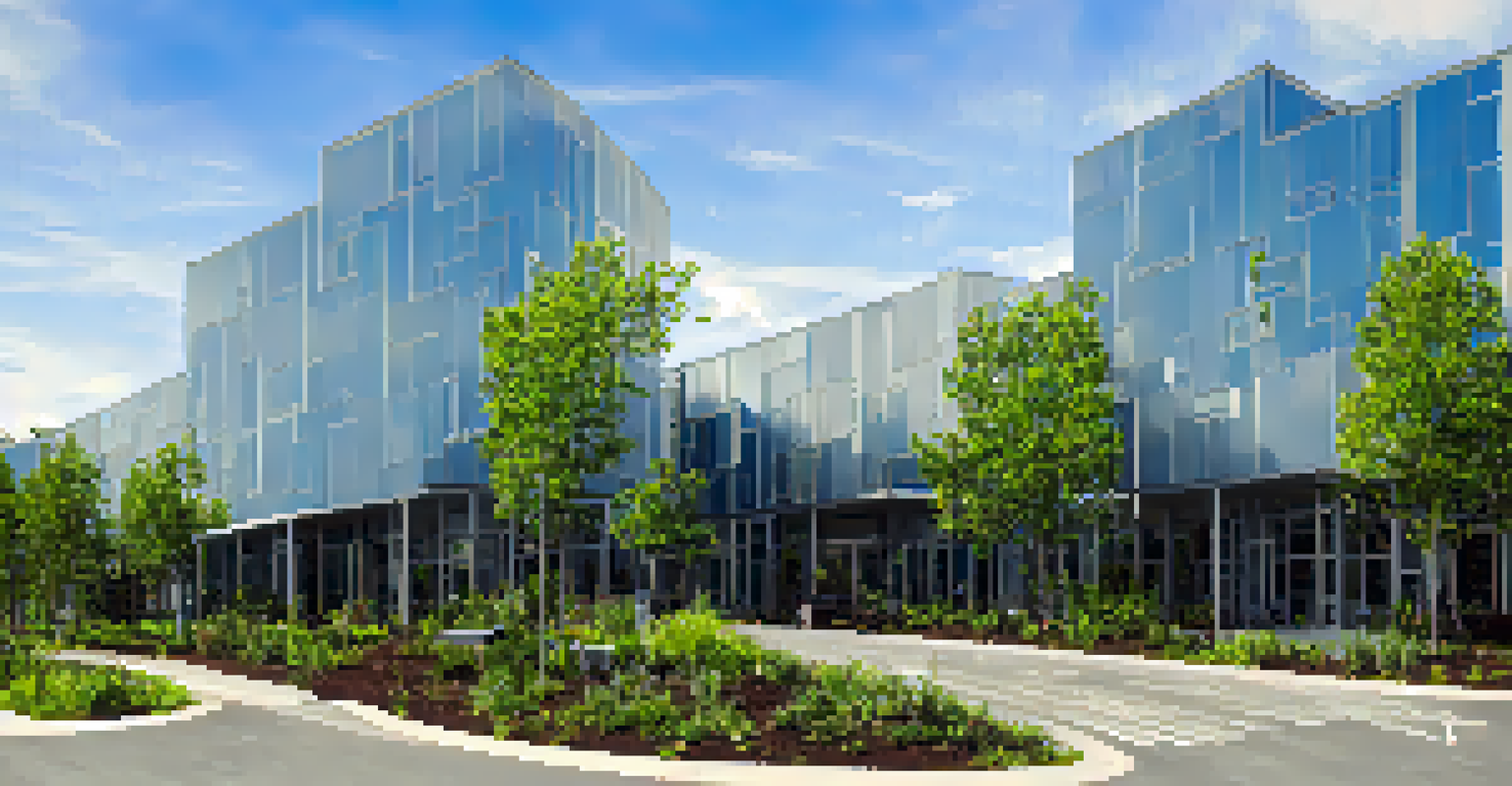Factors Influencing Commercial Real Estate Market Trends

Economic Indicators: The Pulse of Real Estate Markets
Economic indicators, such as GDP growth and employment rates, play a pivotal role in shaping commercial real estate trends. When the economy is thriving, businesses expand, leading to increased demand for office spaces and retail locations. Conversely, during economic downturns, vacancy rates often rise as companies downsize or close, impacting rental prices and investment opportunities.
In the midst of every crisis, lies great opportunity.
For instance, a surge in job creation typically results in more people needing office spaces, which can drive up prices in desirable areas. This relationship underscores the importance of monitoring economic indicators for anyone interested in commercial real estate. Investors who stay informed about economic trends can make smarter decisions regarding property investments.
Therefore, understanding the broader economic environment is essential for predicting shifts in the commercial real estate market. By keeping an eye on these indicators, stakeholders can better navigate the complexities of the market, anticipating both challenges and opportunities.
Supply and Demand Dynamics in Real Estate
The fundamental economic principle of supply and demand heavily influences commercial real estate trends. When demand for properties exceeds supply, prices tend to rise, creating a competitive market. Conversely, an oversupply can lead to reduced prices and less favorable conditions for landlords.

For example, in a city experiencing rapid population growth, the demand for commercial spaces may skyrocket, prompting developers to build more properties. However, if supply outpaces demand—perhaps due to a sudden economic shift—landlords may find themselves lowering rents to attract tenants. This dynamic illustrates the importance of balancing supply and demand.
Economic Indicators Drive Trends
Monitoring economic indicators like GDP and employment rates is essential for predicting shifts in commercial real estate demand.
Understanding these trends helps investors strategize effectively, ensuring they invest in areas poised for growth. By analyzing local market conditions, stakeholders can identify opportunities before they become apparent to the wider market.
Technological Advances: Shaping Commercial Spaces
Technological advancements are transforming the commercial real estate landscape, influencing how spaces are designed and utilized. Innovations such as remote work tools and smart building technologies are redefining the requirements for office spaces. For instance, companies may now prioritize flexible spaces that can accommodate hybrid work models.
The greatest risk is the risk of doing nothing.
Moreover, the rise of e-commerce has shifted demand from traditional retail spaces to warehouses and distribution centers. This shift illustrates the need for property owners to adapt their offerings to meet changing technological demands. Staying ahead of these trends can provide a competitive edge in the market.
As technology continues to evolve, investors and property managers must remain flexible and responsive to emerging trends. Understanding how these technologies impact tenant needs ensures that commercial properties remain relevant and desirable.
Location, Location, Location: The Real Estate Mantra
The age-old mantra of 'location, location, location' remains a cornerstone of commercial real estate trends. Properties situated in prime locations often command higher rents due to their accessibility and desirability. Factors such as proximity to transportation, amenities, and demographics can significantly influence property values.
For instance, a retail property located near a busy shopping district or a transit hub is likely to attract more foot traffic, boosting sales for tenants. Conversely, a property in a less accessible area may struggle to maintain occupancy. This reality underscores the importance of thorough location analysis before investing.
Supply and Demand Influence Prices
The balance between supply and demand directly affects property prices, making market analysis crucial for investors.
Identifying up-and-coming neighborhoods can also lead to lucrative investment opportunities. By recognizing trends in urban development and population shifts, savvy investors can capitalize on properties that are likely to increase in value over time.
Regulatory Changes: Navigating the Legal Landscape
Regulatory changes can have a profound impact on commercial real estate market trends. Zoning laws, building codes, and taxation policies can either facilitate or hinder property development and investment. Staying informed about these regulations is crucial for anyone involved in the real estate market.
For example, a new zoning law that allows for higher density in a particular area can lead to increased property values as developers rush to capitalize on the opportunity. Conversely, stricter building codes may increase construction costs, affecting profitability for developers. Understanding these regulations helps investors make informed decisions.
Navigating the legal landscape can be complex, but staying updated on local and national policies ensures that investors are prepared for changes that may affect their portfolios. Collaborating with legal experts can provide valuable insights into upcoming regulatory shifts.
Sustainability Trends: The Green Movement in Real Estate
Sustainability is becoming a prominent factor in shaping commercial real estate trends. As businesses and consumers increasingly prioritize environmental responsibility, properties that incorporate sustainable practices are gaining popularity. This shift is influencing design choices, construction materials, and operational practices.
For instance, buildings with green certifications, such as LEED (Leadership in Energy and Environmental Design), often attract tenants willing to pay a premium for eco-friendly spaces. Additionally, energy-efficient buildings can lead to long-term cost savings for both tenants and property owners. This trend reflects a growing awareness of the importance of sustainability in real estate.
Sustainability Shapes Market Demand
Properties that incorporate sustainable practices are increasingly sought after, reflecting a growing emphasis on environmental responsibility.
Investors who prioritize sustainability may find themselves ahead of the curve as more businesses seek to align with environmentally friendly practices. By incorporating green features, properties can enhance their marketability and meet the evolving demands of tenants.
Demographic Shifts: Understanding Market Needs
Demographic shifts significantly impact commercial real estate market trends, as changing populations influence property demand. For instance, as millennials and Gen Z enter the workforce, their preferences for urban living, mixed-use developments, and flexible workspaces shape the types of properties that are in demand. Understanding these trends is crucial for investors and developers.
Moreover, aging populations may change the needs for healthcare facilities and senior living spaces, creating opportunities in those sectors. By analyzing demographic data, stakeholders can identify emerging trends and adjust their strategies accordingly. This foresight is essential for staying relevant in a fast-evolving market.

By catering to the needs of diverse demographic groups, property owners can enhance their chances of success. Understanding who your tenants are and what they want can guide investment decisions and property management strategies.